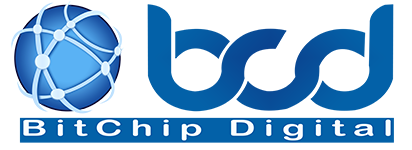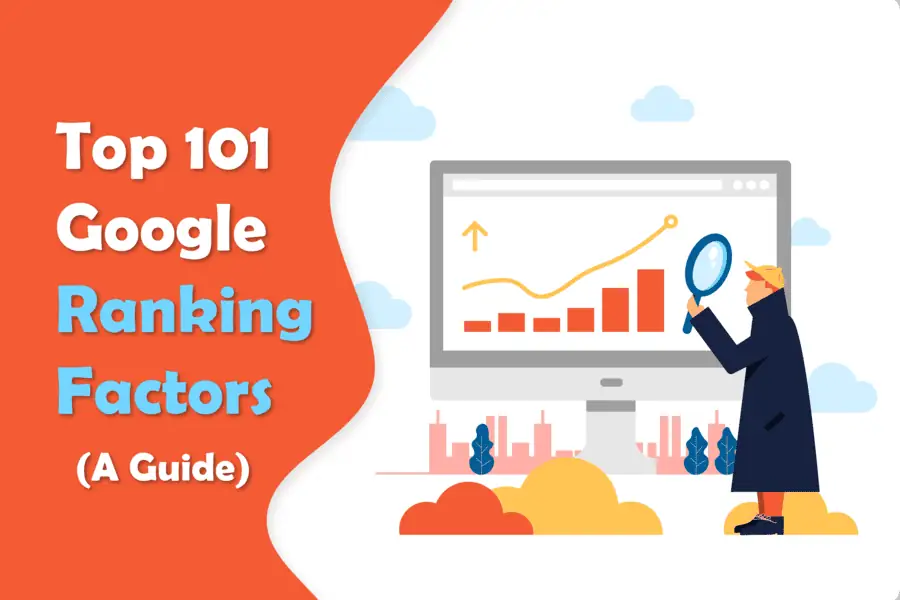
Did you know that over 101 Google ranking factors exist? Google uses these factors to decide how well the content on your web pages matches a specific online search.
Google isn’t the only search engine available. However, they’re by far the most popular and most-used. Below are some key Google statistics that tell you how mighty Google is.
- Google’s market share is 86.19.
- Google records 9 billion searches daily
- An average person conducts 3-4 Google searches daily
- There are over 2.65 billion people in the world using Google Chrome.
- 9 out of 10 internet users in the world prefer using Google search engines.
You can see why Google is so popular. Google search engine also uses sophistcated technology to rank websites and give users a better experience.
So what are the 101 Google ranking factors? Check them out below.
Are These Google Ranking Factors All Proven?
Google has mentioned a handful of factors they use for ranking websites. But they have never mentioned all of them. Most of these factors are still a secret for reasons best known to Google. The popular ranking factors many website owners know are website load speed, mobile optimization, backlinks, and high-quality content.
So where are the 101 ranking factors coming from? The good thing is SEO experts are always working hard to unravel the mysteries behind Google’s search ranking. And we’re not quitting anytime soon. We’ll keep asking all the right questions to unravel the entire ranking factors Google uses.
Some of the ranking factors are proven. Some are unproven, and some are just mere ideas from SEO nerds.
Google utilizes an automated ranking system design to consider the relevance of billions of websites and other content in their search index. They want to ensure people searching on Google find the most valuable results.
Google algorithm update occurs multiple times a year. And when it does, most website owners are left scrambling to get their sites back to where it was before the update.
But if you follow best SEO practices, you may have little to do when Google’s algorithm update hits. Possessing sound knowledge of the ranking factors will enable you to make the right decision to get your site back on track.
When Google updates its algorithm, they usually pass information about the update on their Webmaster Central Blog, including other places.
With the information provided, Google believes website owners can make the right decisions to fix their websites. Below are the 101 ranking factors Google considers.
Ranking Factors Acknowledged By Google
Google has revealed some ranking factors to website owners via blogs, YouTube, and other platforms. Check them out below.
1: Duplication Factors:
To Google, user experience matters a great deal. Thus, they try to display only valuable and helpful content to users.
The duplication system works by identifying duplicate web pages and displaying only the pages considered relevant.
How does this work? When you search for something on Google, you may encounter thousands or even millions of search results for that keyword. Google tries to match these content and display onlthe most relevant content for the search query.
A Handy Tip: When writing your articles, ensure they are worth displaying on the first page of search engine results. Google will only neglect other web pages for yours if your content is valuable and will provide the best value to users.
2: Exact Match Domain (EMDs) Factors
Did you know Google previously utilized the name on domains to determine if the content is relevant to a specific search? Yes, they do.
EMD used to be one of Google’s ranking factors. And they refer to domain names with similar keywords that you’re trying to rank a site for on the search engine result page (SERP).
Exact match domains don’t contain dashes, just the names.
Below are some examples of exact-match domains:
Website owners usually purchase EMDs to give them an advantage in search ranking for the given keywords. Studies have also suggested that having EMD help clicks with PPC, considering that it targets a specific search query.
But things have changed in recent years. Previously, an electrician in California can use the domain name “electriciannearme.com” to boost search ranking. Unfortunately, the chances of this happening today is slim.
With the exact match domain update, the chance of ranking domains containing keywords you want to rank for are very slim. It won’t have any major impact on your search ranking.
3: BERT Factors:
Here is another ranking factor. BERT is an open-source machine learning framework made for natural language processing (NLP).
This AI assists Google in understanding the context of a search to deliver a more relevant and far better result. It can identify users’ real intent, making it possible to obtain superior search results.
How does this AI understand the context or meaning of a word or keywords? It does so by considering the words around the specific word it wants to decipher.
BERT means “Bidirectional Encoder Representations from Transformers. It is a relevant AI, making search engines like Google better prepared to take things to the next level.
Usually, users’ searches are always complex and challenging for Google to interpret. But with BERT, things have become much more straightforward. The AI helps to understand users’ search intent to serve the needed results.
A Handy Tip: Unlike unidirectional language processing artificial intelligence, BERT is smarter. And it is a bi-directional language mechanism.
4: Freshness factors:
Google boasts a system whereby newer content enjoys some priority in search ranking. For instance, let’s say a volcanic eruption happened recently. If you search for volcanoes, you may find news articles about volcanoes rather than general information on the subject.
5: Helpful content factor:
The Helpful Content Update brought the end of “black hat” SEO and ushered in a new era where hardworking website owners were rewarded. This update helps ensure only articles that provided value to users and written by real people were displayed in search results.
Websites containing content written for search engines rather than satisfying users’ intent, were demoted. Organic traffic from Google to those sites also dropped.
Google is more concerned about UX. The search engine giant wants search results to include only content that provides value to users.
6: Spam Detection Factor:
Google doesn’t tolerate spam, but we all know spam is inevitable. Spam is one of the common problems online. Amongst website owners, there are people who, if given an opportunity, would like to receive massive organic traffic without doing any work to earn it.
The way Gmail suffers spam is the same way Google search engine suffers. So, spam is rampant. But as Gmail boasts sophisticated technology to fight spam, so does Google. Google boasts a wide range of tools and techniques for detecting spam and getting rid of them.
The good thing about Google’s “Spam Detection” tools and techniques is that they are updated regularly to stay ahead of spammers before they even get the chance to strike.
So, if you don’t want anything to impact your site’s Google search ranking negatively, avoid spam.
7: Product Review System:
To Google, user experience is paramount. This explains why the search engine giant prioritizes the ranking of valuable content in search results.
Google designed the “Product Reviews System” to reward top-notch reviews and content. These include high-quality reviews written by experts whose researches and content are in-depth and authentic.
The 2021 Product Review System update changed the game. It helped Google to set a new benchmark for product review sites. Websites with poor-quality reviews ranking high were no longer seen in search engine results.
Google focuses on promoting in-depth reviews that help people make informed buying decisions. These include reviews that are in-depth.
The fact that Google doesn’t support poor-quality reviews doesn’t mean sites with poorly written reviews will be penalized. On the contrary, they’ll remain on the Google search engine, buty’ll be severely demoted.
A Handy Tip: If you want your product review to rank high, or appear on search engine result pages, provide detailed and in-depth studies. They are the kind of reviews Google want to keep feeding its users.
8: Reliable Information Systems:
Google focuses on ensuring users’ search queries return the most valuable results. They give priority to high-authority content.
The Reliable Information Systems ensure the content displayed in search results is reliable and authoritative. These systems demote low-authority websites and promote high-quality ones to the first page.
You’ll find Google systems displaying advisories regarding fast-changing topics if there is no authoritative or high-quality content. The reason is apparent. Google wants users to have access to high-quality content.
9: RankBrain:
Google’s use of high technology is no longer news. The search engine giant isn’t just the biggest search engine. They have the most sophisticated technology that makes using the search engine simple and convenient.
What is RankBrain? This AI assists Google, which helps users get the most valuable content when they search for information online. So, it’s quite an important technology.
The most intriguing thing RankBrain does is ensure Google understands how words and concepts relate to delivering relevant content based on users’ search queries. And it does so even if it does not comprise the entire words used in the search.
A Handy Tip: Google rolled out RankBrain on 26 October 2015. And it helps Google to understand and process search queries.
Again, to rank on the first page of search results, ensure you write high-quality and first-page-worthy content.
10: Site Diversity System:
Have you ever searched on Google only to find multiple listings from the same website? Google has fixed that problem via its “Search Diversity System.”

Source: Google Search Liaison
You’ll discover you can no longer find more than two listings from the same website. Well-done Google!
Without this update, a single website would have dominated the search result, which would have been terrible for other hardworking website owners.
11: Passage Ranking System Algorithm:
Google has always been a “user-first” search engine. They always put the users first. That’s why almost all their technology and ranking factors are centered on users. And it’s the same thing with the passage ranking system algorithm.
This AI checks individual sections of specific content to determine which area is relevant to the search query. For instance, if you’re looking for articles on “How To Factory-Reset An iPhone,” Google may display results that discuss this topic.
Some long-form content may have sections dedicated to “How To Factory-Reset An iPhone.” Google might display the article in search results, even though only a section discusses the information you seek.
Passage Ranking System is a powerful AI. The reason for designing the AI is as we have spoken. The essence is to ensure users find what they want online with ease.
12: Legal Removals (Copyrights violation):
Copyright violations can have a massive impact on a site’s search ranking. Google can demote a site if there are many complaints regarding copyright violations.
The complaints have to be valid before Google can react. There has to be clear evidence that there was a violation of other sites’ copyrights. Otherwise, Google won’t respond.
Avoid copyright violations that lead to legal removal. Google won’t only receive copyrighted content. Instead, it will demote other content. Thus, people will find it challenging to locate your content.
13: Google’s Removal-based Demotion System:
Google pays attention to complaints from users about a website. When they receive a request to remove certain content from a website, they’ll act by demoting the specified content.
The complaint must be from numerous users, not just a handful of individuals. Google must have a justifiable reason to wield its demotion axe.
14: Google’s Original Content Systems:
Google has a way of understanding and displaying original content when that specific content gets featured on several websites. How is it possible? The search engine giant relies on its original content system.
This system helps identify and feature original content more prominently in search results to offer value to users. These include canonical markups, which creators can deploy to help Google understand the content on a webpage better.
15: Google’s Neural Matching:
As the name implies, Neural Matching aims to match search queries to the webpage. How? It does so using the text on the search query and webpage.
Neural Matching is an artificial intelligence and crucial ranking signal. Here is Danny’s Tweet about this AI on 24 September 2018.
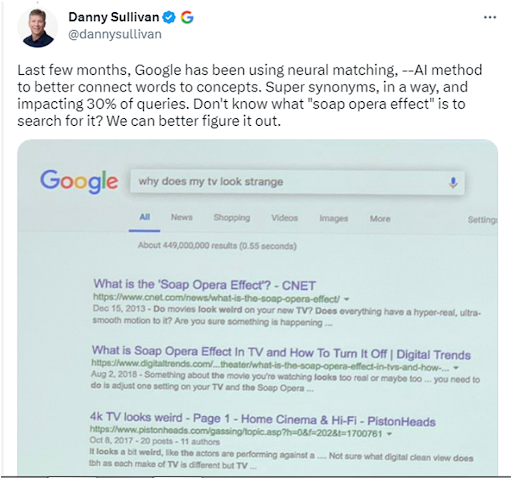
16: Google’s Multitask Unified Model (MUM)
Google published a post on 18 May 2021 about the latest AI it calls MUM. According to the blog post published by Pandu Nayak, Google Fellow and Vice President of Search, MUM can move Google’s level of information understanding to the next level.
Here is a screenshot from the post on MUM.

Google claims MUM has been trained across 75 languages and it can perform several tasks too.
17: Google’s Local News System:
Google has a unique way of displaying news and top stories in search queries for related keywords.
18: Crisis Information Systems:
Google has proven to be a dependable search engine in and out of crisis. Their “Crisis Information Systems” are compelling.
The Crisis information system helps users find information from trusted sources during a crisis. It ensures users find the correct information promptly.
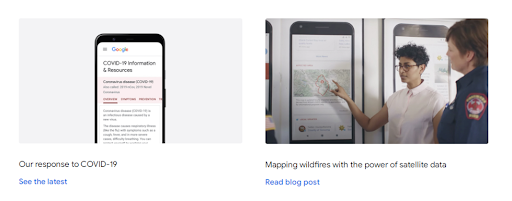
This includes personal crises or natural disasters. Google wants to save people’s life by providing accurate information in these trying times. Thus, they’ll only display the best solutions to users in search results during difficulties.
Gooogle’s Domain Ranking Factors:
What factors will Google likely consider when ranking domains? Check them out below.
19: Domain Age:
Do you believe “Domain Age” is one of the Google ranking factors? Most of us thought this was the case until John Mueller spoke.
In his words, “Domain age helps nothing.” Google’s Mueller has spoken. We have to follow. Here is what he tweeted back then.
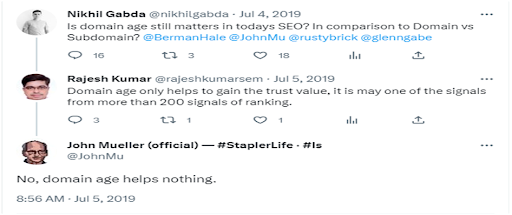
You can see his clear response when asked if Domain Age was essential for SEO, and he said NO! You won’t even gain “Trust Value” with an aged domain.
20: Domain History:
Domain history is a ranking factor. Thus, if someone buys a domain, the domain usage data from the previous owner will be transferred to the new owner.
How a domain was used in the past will determine how Google will treat it. So, yes, Domain history is of the major Google ranking factors.
A Handy Tip: Former Googler Matt Cutts advises that you research a domain before splashing the cash. This way, you can avoid buying a penalized domain.
You can check if a site has been penalized on the Google search console. You’ll find the manual action report for that site.
21: Penalized WHOis Owner:
Here is another important ranking factor. Penalized WHOis owner is a ranking factor that every website owner must take seriously. How does it work?
When Google identifies an individual as a spammer or penalizes a site, they go hard on other sites that the person owns. Google will scrutinize the other sites and probably extend the same treatment.
A Handy Tip: Google’s Penalized WHOis Owner is one reason people who intend to buy websites from others must conduct proper research before they splash the cash.
22: Country TLD Extension:
What is country TLD (Top Level Domain) Extensions? These are internet domains strictly reserved for a sovereign state, country, or dependent territory.
The good thing about TLD extensions is that they help your site rank for that specific country. What’s the bad news? We hate to break it to you, but TLD domains will limit your site from ranking globally.
Check out the 8 best domains:
- .com. – This is not a TLD extension but a no-brainer. You can rank globally with this domain.
- .blog. – This isn’t a TLD extension.
- .co.
- .io. – This domain was once country-specific
- .net. – Shorthand for network
- .org. – shorthand for an organization.
- .tv.
- .us. – TLD extension for the United States of America.
Examples of TLD extensions are:
- .ca.
- .za.
- .pt.
- .cn
- .ng
23: Domain Registration Length:
Many website owners consider “Domain Registration Length” as a ranking factor. But the truth is, Google doesn’t consider this a ranking factor.
What is the myth about “Domain Registration Length?” Most website owners believe registering a website in advance (many years upfront) is a clear signal to Google that you’re a legitimate and committed website owner. They claim it means you want to keep the site for an extended period.
On the contrary, shorter registrations mean a website owner isn’t fully committed or planning to maintain the site for an extended period. Unfortunately, Google ignores this. So, “Domain Registration Length” is not a ranking factor.
Check out what Google’s John Mueller Tweeted:
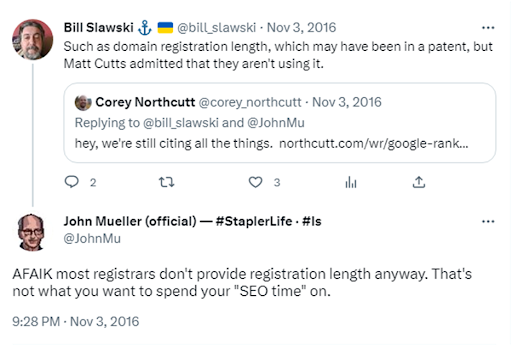
24: Keyword in Subdomain:
Will keywords in subdomain improve your search rankings? According to Moz’s experts, yes it can.
Subdomains can organize your entire website when used correctly. It can make the site user-friendly and a breeze to navigate.
Examples of subdomains:
Here is what Google’s Matt Cutts wrote about subdomains:
25: Public Vs. Private WHOis:
Your WHOis information is essential. And according to what Google’s Matt Cutts said at Pubcon, keeping your WHOis private implies that you are possibly hiding something.
Make search engines trust you. Unfortunately, domain privacy isn’t one way you can achieve that. Therefore, unless you have a genuine reason, keep your WHOis public.
There is evidence that Google can see through your privacy wall. But then, this will only make your website less trustworthy.
26: Keyword in TLD:
Adding keywords in domains used to offer significant SEO boost, but not anymore. Nevertheless, it still serves as a relevant signal.
Google’s On-Page (On-Site) Ranking Factors:
Here are on-page and important ranking factors that Google considers when deciding where to rank your site.
27: Adding Keyword In Meta Description
Does Google consider keywords in Meta description a ranking factor? The clear answer is no! Google doesn’t. However, adding keywords in your Meta description can be a beneficial SEO technique. It could improve the click-through rate, which is a major ranking factor.
28: Keyword in Title Tag:
The title tag is was e a vital on-page search engine optimization signal. Today, it’s not as relevant as it used to be.
29: Starting Title Tag With A Keyword
Adding a keyword in your title tag will help search engines determine a web page’s topic. It also helps search engines differentiate a webpage from another.
A site might boast two web pages that look similar, but with the addition of a keyword in the title tag, search engines can easily differentiate them. So it is beneficial to add a keyword in your title tag.
Moz also stated that the title tag that begins with a keyword performs a bit better than the ones with the keyword at the end of the tag.
A Handy Tip: A title tag is an HTML element that specifies a webpage’s title.

30: Table of Contents:
The table of content improves user experience (UX) and is an on-page improvement. It will also help Google to understand the content of your webpage better.
Unfortunately, Google search doesn’t measure the “table of contents,” and it’s not a ranking factor.
A Handy Tip: A table of content is a great idea for long articles/blog posts. Why? It will make it more convenient and faster for users to navigate to different sections of your articles.
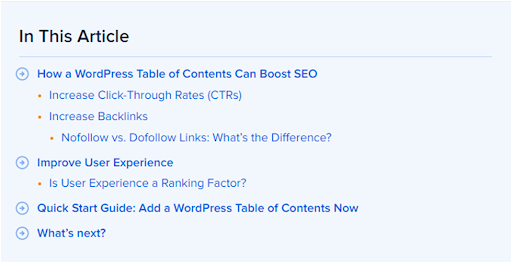
31: Keyword In H1 Tag:
Adding keywords in your header tag signals your page’s relevance for the search query you want to rank that specific webpage for. But is adding a keyword in your H1 tag a ranking factor? The study confirms the critical role the H1 tag plays in search visibility.
Header tags are a ranking factor, and including keywords can help Google to understand the content of your webpage better. However, adding keywords to H1 tags aren’t the only factors that will send your webpage to the top of SERPs.
Here is what Google’s Mueller said about header tags.
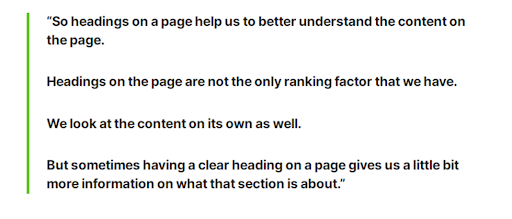
32: LSI (Latent Semantic Indexing) Keywords:
Latent Semantic Indexing Keywords refer to phrases or words semantically related to an article’s primary keyword. Is it a ranking factor? No, it isn’t.
Here is what Google’s Mueller said on this:

Nevertheless, most website owners assume Google only says a few things about their search ranking to ensure they don’t spill their entire secret.
Here are some LSI phrases for the keyword “Is LSI a ranking factor?”
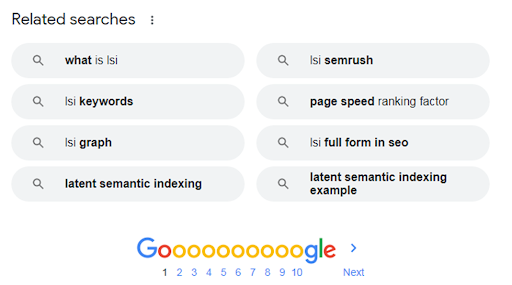
LSI can help Google decipher words that boast two or more meanings. An example is “Apple the Fruit vs. Apple the Firm.”
33: Depth of Topic Coverage:
It is no longer a secret that Google treasures UX. This explains why they keep rolling out sophisticated technology that improves the search experience for users.
Google will give a page that covers an entire topic or provide in-depth information on a subject an edge over a webpage that provides partial information.
34: Word Count:
Content is king. And higher or longer content will exhibit topical authority over short content. Unfortunately, word count isn’t a ranking factor.
The primary thing Google cares about is satisfying the user’s intent. But like we said, a page that provides in-depth information on a topic will have an edge over a webpage that provides partial information.
Here is Google’s John Mueller’s reply on Reddit to a question on word count as a ranking factor:

35: LSI Keywords Added To Meta Description and Title Tags:
The benefit of adding LSI keywords to the Meta description and Title tag is that they help the Google search engine to differentiate between words with two or more meanings. They help make a webpage well-organized and can boost UX. This may serve as a relevance signal of some sort.
36: TF – IDF:
This is simple! A word that appears more in a document is tagged “essential.” And such words will have more weight too.
37: Page Loading Speed:
Page speed is an important ranking factor used by Google and Bing. And in July 2018, Google announced that page speed would become a ranking factor for mobile searches.
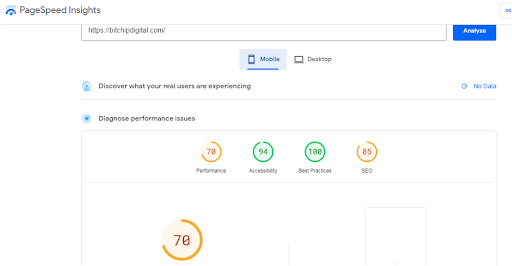
A Handy Tip: A faster site will enable you to rank better in SERPs. Another thing you need to know is page speed is a ranking factor whether on desktop or mobile.
Here are some of the tools you can use to check your website’s speed:
- Sematext
- Uptrends
- GTmatrix
- WebPage Test
- Dot-com monitor
- Pingdom Speed Test
- Google PageSpeed Insight (Free)
38: Duplicate Content:
Having two similar or identical articles on the same website isn’t favorable for your search visibility. Google says it can negatively impact search visibility.
39: Image SEO:
In 2020, over 25% of organic traffic came from image searches. Moz and Jumpshot’s recent study also indicates that Google image search rank as the second most popular search platform, and it’s behind Google.com.
You need to optimize your images for them to appear in Google searches.
Now, is image SEO a ranking factor? Images send crucial relevance signals to search engines via descriptions, file names, captions, titles, and alt text. Image SEO is also part of an on-page optimization effort to boost organic traffic and search ranking.
A Handy Tip: Images may send a relevant signal to Google but are not a ranking factor. In addition, the number of images you have on your webpage isn’t considered a ranking factor.
40: AMP Usage:
Is AMP a Google ranking factor? No, it is not. Is it important? Yes, it is. You may need it to rank in Google News Carousel’s mobile version. Google has also provided an elaborate explanation of how AMP works in search results.
41: Entity Matching:
Is the web page’s content match the entity a user searches for? If yes, said page will receive a ranking boost for the specified keyword.
42: Rel= “Canonical” Link Element (Canonical Element):
Do you want to ensure Google doesn’t penalize your website for duplicate content? If yes, you must understand how to deploy the Rel= “Canonical” Link Element.
43: Google Caffeine:
On 28 June 2010, Google announced a new web indexing system called “Caffeine.” According to Google, Caffeine provides 50% fresher results for web searches compared to the last index. Google also acknowledges it as the most extensive collection of web content offered.
Google uses Caffeine to ensure updated or recently published content is favored, especially time-sensitive content.

44: Google Hummingbird:
In the past, keywords enabled Google search engines to understand what a webpage topic is. Today, Hummingbird, the search engine giant, goes beyond relying on keywords to understand a web page’s topic.
Hummingbird was a massive algorithm update and the first since the Caffeine update. It was updated in 2013 and described by Google as the most significant algorithm update since 2001.
A Handy Tip: Google called this update “Hummingbird” because it was sharp and fast. It was designed to perceive what a user was looking for not just based on keywords alone but search intent.
45: Historical Page Updates:
Google favors fresh content, as you already know. Therefore, it would help if you kept your content fresh. How often do you update your webpage? Or, how often have you updated your webpage?
Do you perform updates daily, weekly, bi-weekly, yearly, or every five years? The choice is yours to make. But remember that how frequently you update your webpage plays a crucial role in freshness.
46: Magnitude of Content Updates:
Another “freshness factor” considered when updating content is the gravity of the edits or changes made. Did you remove and add an entire section to the edited content? Or, you changed the order of the words alone and called it a day.
Removing and adding a complete section is far more significant than switching things around or fixing a typographic error.
47: Outbound Link Theme:
Here is why linking to any page you come across is not advisable. Hilltop Algorithm has shed light on the Outbound Link Theme, and it could be terrible for web pages linked to inappropriate content on a webpage.
Why? When you are linked to a page’s content, Google may decide to use the content of that page as a relevancy signal.
Here is what I meant:
If you have a page about cars and link it with a page that focuses on movies, Google will think your content is about movie cars and not automobiles.
48: Keyword Prominence:
Does placing a keyword in the first 100 words of a webpage’s content correlates to Google’s first-page ranking? Yes, it is.
49: Spelling and Grammar:
Proper spelling and grammar are signals of professionalism, quality, and credibility. Similarly, poor spelling and grammar can hurt your SEO long-term.
How? Visitors may leave your page quickly When they don’t find what they’re looking for or feel satisfied with your content. And this may impact the bounce rate.
A Handy Tip: Spelling and grammar aren’t directly important ranking factors. However, Google is one of many search engines available.
Another thing you need to know is even though spelling and grammar aren’t direct ranking factors, they may influence your visitors. Content with proper spelling and grammar builds trust and instills confidence in your visitors.
50: Mobile-friendliness:
Mobile-friendliness, or “Mobilegeddon,” as fondly called, is a confirmed ranking factor. A website needs to be mobile-friendly to rank for mobile searches. In other words, it will appear in search results for mobile device users.
A webpage that isn’t mobile-friendly will display less information on mobile than on a desktop. And this will affect search ranking massively.
51: Incorporating Keywords in H2, H3 Tags:
There is a chance that adding a keyword in H2 and H3 to make it appear as a subheading is a relevance signal. Even though it might be weak, any effort to boost search ranking should be paramount.
Google’s John Mueller stated, and I quote, “These heading tags in HTML help us understand the structure of the page.”
52: Mobile Usability:
Google made its “mobile-first” indexing update in 2020. And they expect new websites not previously known to Google to follow SEO best practices for mobile-first indexing.
What does mobile-first indexing means? It refers to the system where Google uses a site content’s mobile version crawled with the Smartphone agent for indexing and ranking.
53: Supplementary Content:
What is supplementary content? This refers to the content added to the main piece to provide value and adds utility to the primary content. Examples of supplementary content include:
- Interactive recipes
- Currency converter
- Loan interest calculator
You can see that the above contents are helpful through the supplementary pieces. They will add value to the main content.
54: Syndicated Content:
It is good for content to be 100% original. Otherwise, it may rank below the original or indexed page. In the worst-case scenario, Google crawlers may not even index the copied or scrapped content.
55: Outbound Link Quality:
Does outbound link quality impact a webpage’s search ranking? A study by Reboot, a digital marketing firm, confirms a positive correlation between a webpage’s ranking and outbound links.
56: Content Hidden Behind Tabs:
If there are content users must click on a tab to access, and you want the content indexed, Google says you won’t get your wish. Such content will remain un-indexed.
There is nothing wrong with hidden content. You can keep them on a webpage, but if you feel the content is essential, you should make them visible. You can watch what this Googler said about hidden content.

57: Multimedia:
Adding multimedia like videos, images, and others in a content is a good idea. These improves content quality and serve as a quality signal. But they are not ranking factors.
58: Amount of Outbound Links:
Outbound links are beneficial for SEO. But do not focus on acquiring do-follow links only. Why? It can leak your PageRank and hurt it massively.
59: Broken Links:
Do you have tons of broken links on a webpage? It is time to fix them so Google won’t assume anything negative about your website.
If you have numerous broken links on your webpage, Google will assume you have abandoned or don’t care about the site anymore. Google considers broken links when assessing a homepage’s quality.
60: Affiliate Links:
Does affiliate affect a website’s ranking? No, it doesn’t. But if you have tons of links littered on your website, you’ll force Google to start paying more attention to your site. They want to ensure you’re not one of those affiliate websites.
61: URL Path:
A webpage closer to the homepage enjoys some advantages over one buried deeper and far away from the homepage. The webpage sitting close to the homepage will enjoy some authority boost.
62: Contact Page:
The Google Quality Document is clear about contact page. You can deduce from the document that Google treasures websites with enough contact information. So, provide your contact information and ensure they match your WHOis info.
63: HTML/W3C Validation:
W3C (World Wide Web Consortium) allows internet users to check a site’s HTML and XHTML documents to ensure well-formatted markup. Validation helps improve the website experience, teaches best practices, makes the website browser-friendly, and makes multiple devices accessible, including easy coding and maintenance.
W3C validation offers numerous SEO benefits that may impact search ranking. And remember that many SEO experts still assume a well-coded webpage serves as a quality signal.
64: Internal Links Pointing To Page:
Did you know internal links pulled from authoritative pages on the domain would have the most impact compared to a low PageRank or no link webpage? Here is what Moz wrote about internal links.
65: Reading Level:
The reading level is not a direct ranking factor. However, it can affect your bounce rate. If visitors find your content too difficult to read, they may leave quickly, leading to a higher bounce rate.
66: Page’s PageRank (PR):
PageRank is one of the numerous factors Google considers when ranking pages in search results. It is also an important SEO metric. Pages with high author
67: URL Length:
URL length can have an impact on a page’s search visibility. And according to a study, short URLs have an edge over long URLs in Google’s search results.
68: Domain Authority (DA):
Domain authority is a ranking score Moz developed to help website owners determine where their websites would rank on Google search results. It is not a ranking factor, nor will it impact your site’s search ranking.
But ceteris paribus, a webpage on a high authority domain has a better chance of ranking than a webpage on a domain with less authority.
69: Webpage Category:
The category of a specific webpage feature serves as a relevancy signal. However, page category isn’t a ranking factor.
70: Page Age:
Google loves fresh content. There is no doubt about that. However, an old page that receives regular updates will outperform a new page updated regularly too.
71: References And Sources:
Research papers thrive on citations of references and sources. A research paper without citations may be treated differently from one that includes citations of references and sources.
Using references and sources on blog posts may indicate to Google that the webpage is of good quality. Unfortunately, Google has debunked the myth that citing sources is a ranking factor.
A Handy Tip: Adding references and sources to your content can benefit SEO. When you add the links to your content, you allow users to read further and stay on your blog. This may lower the bounce rate and improve your search ranking.
72: Outbound Links Too Many:
You may struggle to retain your visitors if your page contains too many links. Why? You are distracting the main content, and visitors don’t like that.
73: User-friendly Layout:
A user-friendly layout is essential, as it makes the content of the highest quality page visible. You can check the Google Quality Guidelines Document for more on a user-friendly layout.
74: User Signal When A Website Ranks For Other Keywords:
Did you know Google rates a site high when it ranks for other keywords? They see such sites as high-quality sites.
In Google’s “How Search Works” the search engine giant stated that they look for websites that users value for similar search queries.
75: Adding keyword in URL:
Is there any benefit in adding keywords to the URL? Yes, there is. Including keywords in the URL is a relevance signal. A Google rep has even tagged it as a tiny ranking factor.
76: Numbered Lists and Bullets:
Did you know Google itself prefers content broken down with numbers and bullet lists? Using numbers or bullet list help to make the content user-friendly and easy to understand. It’s one way you can improve user experience.
77: Human Editors:
We have been hearing rumors of Google filing a patent for a system that permits human editors to exert some influence on SERPs. What is Google up to this time? Only time will tell.
78: Parked Domains
Are parked domains valuable? A Google update in 2011 has answered this question. In the update, Google stated that it had decreased parked domains’ search visibility.
79: Priority of Page in Sitemap:
Did you know the priority a page enjoys via the sitemap.xml file has some influence on search ranking? Yes, it does.
80: URL String:
The URL string provides vital information that can help Google to understand better what a webpage is majorly about. This can have some impact on search ranking. By the way, if Google doesn’t understand a webpage’s content, how will such a page be ranked?
The keyword was “benefits of SEO. And as you can see, it was embedded in the URL. Google will quickly understand the webpage’s content.

On-Site Ranking Factors Google Considers
Google considers several on-site factors for search ranking. Here is the list below.
81: Site Uptime:
Uptime is an essential factor Google considers when ranking a website. When Google index a site, it adds it to its regular crawler.
What does this imply? It means Google will test load web pages from your site frequently. Thus, the more popular your website is, the higher the possibility of Google crawling it.
We’re trying to say that Google uses uptime as a ranking factor. So, it plays a crucial role in SEO.
What is uptime? Uptime refers to the amount or number of times a website remains accessible to users. Uptime is an integral part of website performance crucial to overall business success, search engine optimization, and UX (user experience).
Uptime is essential in search engine optimization because search engines like Google prioritize websites’ availability and accessibility to users.
How Google’s algorithm works shows why uptime is a crucial factor that website owners must pay attention to. Google designed the algorithm to favor websites that deliver high-quality content and positive user experiences.
Unfortunately, downtime won’t make both possible. When your site is down, visitors cannot access your website and content. This action will cause an increase in bounce rates, affect search ranking, and impact user experience negatively.
A Handy Tip: Ensure your website is up all the time or most of the time because of search engine crawlability. Google crawlers cannot crawl and index your site when down.
If this continues, search engines may consider your website unreliable, and you know what that means. They may decide to lower your search ranking for other website owners to take your site’s space.
82: SSL Certificate:
Is HTTPS a ranking factor? The answer is yes. However, HTTPS boasts a slight impact on the ranking signal. Google refers to it as a tiebreaker.
![]()
In other words, if two relatively equal sites are fighting for the same position on the search engine result page, the website with HTTPS may have the upper hand.
HTTPS makes websites safe for users. And Google values it. Here is a statement made by the search engine giant.

Websites encrypted with HTTPS can boost search ranking than websites with HTTPS. The added security makes the site better for online visitors. And as you know, Google highly rewards websites that offer better user experience.
There are claims that the HTTPs’ high signal strength varies from extreme to extreme.
83: Mobile Optimized:

Is your website mobile optimized? If not, then you’re giving your competitors an edge. Mobile optimization is a confirmed Google ranking factor, so webmasters must take it seriously.
The number of mobile device users is increasing daily.
There are 6.84 billion smartphone users in the world. That’s roughly 85% of the world’s population of 8 billion.
79% of customers order online through mobile devices. This shows you how vital mobile device is to search engines.
So, mobile optimization is a top Google ranking factor. Thus, if you don’t optimize for mobile devices, you won’t rank for mobile searches.
A mobile-optimized website displays a web page on mobile devices like on the desktop. The reverse is the case for mobile-optimized sites.
Google uses information on a web page for search ranking. Thus, if a web page displays less information, Google won’t find enough contexts to rank it.
So, your ranking is impacted if you provide a lesser experience on mobile devices than on desktop. That’s what Google says.
Other Google Ranking Factors To Consider
We grouped myriads of Google ranking factors webmasters need to know. Check them out below.
84: Core Web Vitals:
Is Core Web Vitals (CWV) a ranking factor? Yes, it is. Google has confirmed page experience signals and Core Web Vitals as ranking factors. But they’re less critical than search intent, content, or links.
So if your website score is low, you’ll receive less organic traffic. This has been the case for mobile and desktop since June 2021 and February 2022, respectively.
It is clear to everyone that CWVs are ranking factors, but note that the quality of content counts. You need to provide high-quality content to rank.
Google’s web.dev has been helpful to webmasters, providing information on how to improve several ranking signals. You’ll find crucial information on improving FID, LCP, and CLS to boost user experience and search ranking.
So, yes, Core Web Vitals is a confirmed ranking factor. They help measure page experience signals. Google prioritizes websites that provide a great user experience. Thus, your website will have a competitive edge if you deliver quality content and other CWVs.
A Handy Tip: Google uses Core Web Vitals to measure a page’s visual stability, interactivity, and loading performance, using three metrics. These are LCP, FID, and CLS.
LID is the Largest Contentful Paint; FID is First Input Delay, while CLS means Cumulative Layout Shift. Hitting the performance range “good” in all three metrics is a considerable feat.
85: Site Usability:
Site design is a ranking factor, but a factor Google’s John Mueller terms “soft ranking factor.” Soft ranking factors are crucial, depending on how they are on your competitors’ sites. They may serve as tiebreakers when competing with other websites in search ranking.
Website usability is a new but increasingly popular ranking factor. And it offers twofold benefits. First, it impacts user experience and can improve bounce rate. People will love spending time on we-designed sites. They’ll find it easier to move from page to page on such websites.
Another benefit of website usability is search ranking. It can give your website a competitive edge in search engine rankings.
86: Backlink:

A study by Backlinko discovered that the number of authority links pointing to a web page was one of Google’s most significant ranking factors. The more links you have from various authority websites, the higher your chances of ranking for targeted keywords.
Ahrefs did research back and discovered that 43% of all top-ranking pages on Google’s search engine contain reciprocal links. Several studies have also suggested the same.
Google released a brand new link spam update on December 15, 2022, which focused on the quality of backlinks. They stated that unnatural or spammy links would be neutralized. They’ll also lose link juices or credits passed forever.
Google is actively waging war against spammy and unnatural links, using a powerful artificial intelligence called “SpamBrain.” This AI can detect websites buying links, and another aim is to pass link juice to other websites.
A Handy Tip: If links between two websites are commercial, consider marking them with “rel =” nofollow” or “rel =” sponsored.” Or, you can utilize other rel values following Google’s specifications.
The reason for marking commercial links with real value is simple; Google’s SpamBrain won’t identify them as spam. With this, there won’t be a negative impact on your website’s search ranking.
87: EAT (Experience, Expertise, Authority, and Trust):
There has been no evidence that Google’s algorithm can measure EEAT, So there is a big question mark on its status as a ranking factor. But we know that Google wants to serve results with strong EEAT.
If EAT isn’t a Google ranking factor, then what do Google ranking factors entail? The definition of Google ranking factors includes factors that influence search rankings.
Can EAT influence search ranking? Yes, it can, to a large extent. EAT implies experience, expertise, authority, and trust. Users will consider your content valuable when you provide content that fulfills these demands.
Google prioritizes websites that provide better UX. Thus, your search ranking will be impacted positively if your website is well-designed, loads fast, is optimized for mobile search, etc., and your content shows strong EAT.
A Handy Tip: The EAT ranking factor doesn’t exist. In other words, Google doesn’t have specified EAT scores or ratings as they do for Core Web Vitals.
However, EAT plays a crucial role in how Google perceives web content. Google mentioned it 135 times on its 167-page “Search Quality Evaluator Guideline.”
Google is seriously fighting disinformation, as shown in its 2019 Whitepaper. Thus, anything that matches EAT in Google’s book will receive higher priority in its search ranking.
88: Search Intent:
Search intent is an essential ranking factor. SEO experts create their content around it. Google’s interest is to fit rank web pages that best match the search term people are using, including the search intent behind the search query.

So search intent is essential for search engine optimization. In the past, online visibility was practically about the use of keywords. This led to keyword stuffing, where website owners could rank low-quality content using the right keyword.
Now, search has gotten more intelligent. What are people looking for when they enter a query in the search engine? Provide the right answer, and you can optimize your content, including your website, to match those specific needs.
We’re not saying keywords have lost their value. On the contrary, keywords are still vital. But the way search is now is that you cannot neglect your visitors’ wants and needs. You must incorporate search intent in your content.
A Handy Tip: Search intent refers to the underlying reason a person decides to search online. When you understand what people are searching for, you’ll be able to create content that meets their specific needs and help them find what they’re looking for.
You can determine search intent in several ways. These include using software tools, Google’s “People Also Ask” feature, or viewing SERPs for clues.
Off-site Web Spam Factor:
90: Links Obtained From Unrelated Websites:
Inbound links are a top Google ranking factor. Every webmaster knows that. Google built its first algorithm on PageRank, which depends only on links to rank web content.
PageRank counts the number and quality of links pointing to a site. It uses that to determine the content’s quality.
Google has upgraded its algorithm, but links remain one of its ranking factors. The update only broadened the factors Google considers when ranking a site.
Now, here is a question. Can links from unrelated websites positively impact a page’s ranking? The answer is no! Google pays attention to relevance when rating inbound links. Don’t be surprised that Google may even ignore some of your links.
The number and quality of links one has doesn’t matter much to Google. That’s what Google’s John Mueller said. He claimed that one relevant link could have a massive impact.
So the number or authority of links pointing to your website doesn’t matter much. And it would be worst if the links weren’t niche-relevant. Google believes people can manipulate the authority of links. They may do all they can to acquire links from authority sites.
On the contrary, no one can manipulate site relevance. You cannot change the site from one niche to another.
When acquiring backlinks, getting links from relevant sites is always the primary focus. Only relevant links can positively impact your site’s search ranking.
91: Penguin Penalty:
No one will voluntarily ask for a penguin penalty. This Google penalty affects search ranking and traffic.
Google launched the Penguin Update, called the Webspam algorithm update, back in 2012. Its role was to reduce the number of websites showing up on Google search engine result pages with the help of link schemes acquired via black hat.
The Penguin penalty won’t zero in on a site that builds links via a white hat link-building strategy. It will only come from websites that use black hats or try to manipulate the system.

Here are link-building strategies that can incur Penguin’s rot.
- Links bought
- Bot-built links
- Links from irrelevant sites
- Links acquired via Black hat
- Links using the same anchor texts
- Links from untrustworthy sources
A Handy Tip: Penguin penalty can cause a website’s traffic and search ranking to drop. However, you can recover from it. Just identify where the problem is and address it.
If bot-built links are on your website, remove them immediately. Furthermore, only approach niche-specific websites for link building.
92: Google Sandbox:
Are you just starting a new website? Have you heard of the sandbox effect? New websites are challenging to rank immediately. Some SEO experts even believe new websites must reach a certain age to start ranking.
In the SEO world, this is what we call the Sandbox effect. This idea dates as far back as 15+ years ago. At some point, SEO experts noticed that ranking a site on other search engines (Bing and Yahoo) was much easier than on Google search engines.
How long does it take to rank a site considering the sandbox effect? While some experts assume it can take a month or a whole year, some think it’s when the website SEO is in order and you start getting organic traffic.
Does Google Sandbox exist? Here is Google’s Gary reply to a similar question:
Gary is one of many prominent Googlers to have responded to the question on Sandbox. Here is a video reply John Mueller gave regarding Sandbox in 2018:
In summary, he said:
“Regarding the sandbox, Google doesn’t possess the traditional sandbox many SEO was referring to in years past. Rather, what we have are algorithms that appear similar. But algorithms try to understand how a website fits in with the rest of the websites trying to rank for a specific search query.”
From John Mueller’s reply, one can easily deduce that a sandbox exists. The only thing the SEO community got wrong is the name. Google’s John Mueller didn’t deny that new websites are treated differently from old ones.
So, Google, since there is no specific name for sandbox, we prefer to leave things this way.
93: Anchor Text:

Anchor text is a confirmed Google ranking factor. Google uses it to gain a deeper understanding of web pages to help display them for relevant search queries.
We can all agree that anchor text’s current strength, as a ranking factor, can’t be compared to the period before penguin updates. Nevertheless, it still holds much relevance in search engine optimization and ranking.
In one of Google’s John Mueller’s recent question and answer section, he reiterated that anchor text is still a ranking factor. The Q&A section was with an SEO community where questions on anchor text are popular.
A Handy Tip: Ensure no “poison” anchor texts are pointing to your website. Why? Such anchor texts tell Google that the site has been hacked or is spam. Note also that poison anchor text can hurt your Google search ranking.
Brand Signal As A Ranking Factor:
94: Legitimacy of Social Media Accounts

The legitimacy of social media accounts isn’t a confirmed ranking factor. Social media is not a ranking factor, either. However, a website with a robust social media presence may rank higher than others for specific search queries.
Social media may also increase website traffic, which may impact search ranking. Social media can positively impact your website’s search rank in different ways.
One of them is brand signal. Getting mentioned on a blog or website without hyperlinks can impact search ranking. Google tags it as “co-citation,” which is a strong brand signal.
You can increase brand awareness and initiate conversations around the brand. All of these can lead to co-citations.
Another way social media can impact search ranking is its link potential. It can increase brand awareness, which can help you acquire valuable backlinks.
Suppose a brand posts a video about a new product’s features. Social media users will find the video ad and share it. One of the persons that come across the video happens to be a website owner or blogger.
The person may write about the product and add a link to the brand’s website in the article. That’s how social media can help you build backlinks naturally.
The fact that the person deemed fit to write about the product means their website is relevant to yours. So, it’s a big plus for your brand and search ranking.
95: Site Over-Optimization
Does over-optimization exist? Google’s Gary Illyes says yes, it does. And over-optimization can hurt your website’s ranking. Here is Google’s Gary’s reply when asked about over-optimization:
96: Brand Mentions on Top Stories
Google’s John Mueller explains that Brand mentions are not one of Google’s ranking factors. Google doesn’t have a way of understanding the rationale behind why a site may decide to mention another.
Brand mentions are crucial nonetheless. You can use them to build brand awareness or make a site more popular.
Forget about what John Mueller said about brand mentions. The truth is, it does count. Don’t count on Google to reveal all its ranking factors to the public. They’ll never do that or have never done that since inception.
Brand mentions are vital. Note that Google wants to display naturally popular and authoritative websites in SERPs.
Google sees brand mentions as implied links, and this will enhance your website’s SEO.
Onsite Web Spam Factors
97: Interstitial Pop-ups:
Google wants websites to avoid intrusive interstitials and dialogues. Why? They make it harder for Google algorithms to understand a website’s content, leading to poor search performance.
Source: Google
What is a mobile interstitial ad? This refers to ads that cover a web page, preventing a user from accessing the content on the page.
Two types of interstitials exist. The first is ads that cover part of the web page or cover the web page partially.
The second is interstitials that cover the entire web page. In this case, users must close the ad to access the content.
Here is Google’s announcement regarding mobile interstitials in 2017.
Google inferred that they would make mobile interstitials a negative ranking factor. They claim such ads can trigger a negative ranking factor.
A Handy Tip: There’s nothing wrong with displaying interstitials on a web page. Just follow Google-approved interstitials, and your website will be fine. What does Google want?
According to John Mueller, if the first thing that visitors encounter when they land on your site is interstitial, not the content or information promised, that can lead to a negative user experience.
There are ways to show interstitials without incurring Google’s rot or creating a negative user experience. Rather than displaying the interstitial immediately after the users land on your site, you can display ads mid-way into a game or something.
For instance, if a visitor lands on your site and starts to play a game, you can display interstitials mid-way through the game or after a while. Google won’t consider it a negative ranking factor. And it won’t impact your site’s search ranking.
You can watch a video on how to use interstitials for better understanding. But keep this in mind: Google wants users to find your content when they access your website, not interstitial ads.
98: Hiding Affiliate Links
Does your website contain affiliate links? Are you considering hiding them and thinking that is a good practice? You’re not alone. But hear this before you make such a move.
There is no reason for you to hide your affiliate links. Google could penalize you for this.
Affiliate links are links used to promote other company’s products and services. Website owners receive a commission when people purchase these products using affiliate links.
Google is not against the use of affiliate links. They only want website owners using affiliate links to do so appropriately.
John Mueller said using affiliate links is not an issue. Just ensure you don’t try to use automatic JavaScript or cloaking. And even if you use JavaScript, endeavor to use the correct attributes there.
What is the best way to use affiliate links?
- Don’t hide affiliate links. There’s no need to do so. Just link to the affiliate platform and declare your links so that Google can treat them appropriately.
- Your content should be valuable and helpful to readers. Provide unique content.
- When you add affiliate links to your content, ensure they don’t negatively impact user experience.
Special Google Algorithm Rules:
99: DMCA Complaints:
Google has clarified that DMCA isn’t a ranking factor and has never been. However, it can impact a website’s search engine ranking.
Google may react if you have many valid DMCA complaints (a valid take-down on a site). They may remove the affected content from search engines. And this may affect your website.
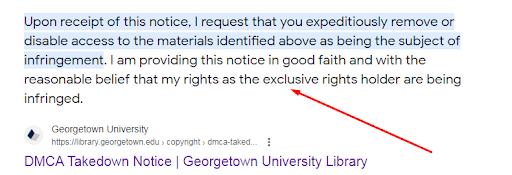
A Handy Tip: Google responded to a question on DMCA complaint. The response was any URL whose take-down request has been successfully served to Google might be deleted.
Such take-down requests are trickier than they may seem. It will take many valid requests for Google to consider taking action.
100: Page-Level Relevancy:
When we talk about page-level relevance, off-page SEO is the primary focus. Off-page SEO involves what you do outside your website to increase search ranking. These include building backlinks, social media, local SEO, etc.
So, is page-level relevance a ranking factor? Page-level relevance implies a link’s relevance to the content on a page. When a link from a web page is related to a page’s content, it will have more value than a link from an unrelated web page.
This search ranking factor is from the Hilltop algorithm, where it is stated that a web page’s document should have content that is related to the keyword.
The Hilltop algorithm laid the foundation for modern SEO. This algorithm aimed to identify authoritative documents and web pages to rank.
A Handy Tip: Page relevance is essential. Keep that in mind when building backlinks. The number of backlinks you have won’t matter if all of them are from unrelated pages.
101: Disavow Tool:
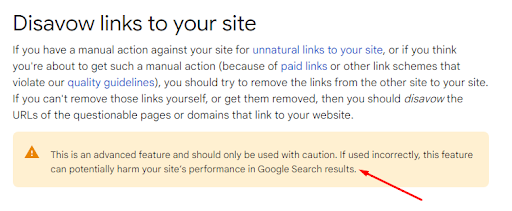
Google’s John Mueller affirms no penalty or black flag for utilizing the disavow tool.
The disavow tool removes links you don’t want to be associated with. You can use it for links you created yourself.
John Mueller says there is no need to use disavow tool for random links. It’s not necessary. He also assured website owners that a disavowed file isn’t an admission of link-building guilt.
A Handy Tip: In John Mueller’s words, there is no kind or sign of wrongdoing in the past once a website is cleaned from a specific manual action.
However, while some issues cleaned up might take a while to settle, others might take a little. That’s because Google needs time to reprocess everything that concerns the website.
Conclusion
You have seen the list. Yes, it’s a comprehensive list. However, below are the most important Google ranking factors for 2023:
- Backlink
- Freshness
- Relevance
- HTTPS
- Page-Speed
- Mobile-friendliness
- Core Web Vitals
- Intrusive Interstitials
You can rank your website by following the best SEO practices. But note that SEO isn’t a one-off process. Continue doing the things you did that took you to the first page of search engine results.
If you cannot handle your SEO and improve your website’s search ranking, you can find an expert to help you. Putting your website on the first page will enable prospects to locate you online quickly. And remember that the first page is where 70% of searches end.
